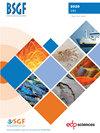Post-Paleozoic evolution of the northern Ardenne Massif constrained by apatite fission-track thermochronology and geological data
IF 2.6
3区 地球科学
Q2 GEOSCIENCES, MULTIDISCIPLINARY
引用次数: 11
Abstract
The exhumation history of basement areas is poorly constrained because of large gaps in the sedimentary record. Indirect methods including low temperature thermochronology may be used to estimate exhumation but these require an inverse modeling procedure to interpret the data. Solutions from such modeling are not always satisfactory as they may be too broad or may conflict with independent geological data. This study shows that the input of geological constraints is necessary to obtain a valuable and refined exhumation history and to identify the presence of a former sedimentary cover presently completely eroded. Apatite fission-track (AFT) data have been acquired on the northern part of the Ardenne Massif close to the Variscan front and in the southern Brabant, in particular for the Visean ash-beds. Apatite fission-track ages for surface samples range between 140 ± 13 and 261 ± 33 Ma and confined tracks lengths are ranging between 12.6 ± 0.2 and 13.8 ± 0.2 μm. Thermal inversion has been realized assuming that (1) samples were close to the surface (20–40 °C) during Triassic times, this is supported by remnants of detrital Upper Permian–Triassic sediments preserved in the south of the Ardenne and in the east (border of the Roer Graben and Malmedy Graben), and (2) terrestrial conditions prevailed during the Early Cretaceous for the Ardenne Massif, as indicated by radiometric ages on paleoweathering products. Inversion of the AFT data characterizes higher temperatures than surface temperatures during most of the Jurassic. Temperature range is wide but is compatible with the deposition on the northern Ardenne of a significant sedimentary cover, which has been later eroded during the Late Jurassic and/or the Early Cretaceous. Despite the presence of small outliers of Late Cretaceous (Hautes Fagnes area), no evidence is recorded by the fission-track data for the deposition of a significant chalk cover as highlighted in different parts of western Europe. These results question the existence of the London-Brabant Massif as a permanent positive structure during the Mesozoic.受磷灰石裂变径迹热年代学和地质资料约束的北阿登地块后古生代演化
由于沉积记录中存在较大的缺口,基底地区的发掘历史约束较差。包括低温热年代学在内的间接方法可用于估计挖掘,但这些方法需要反向建模程序来解释数据。这种模型的解决方案并不总是令人满意,因为它们可能过于宽泛,或者可能与独立的地质数据相冲突。这项研究表明,为了获得一个有价值的、精确的挖掘历史,并确定目前完全侵蚀的前沉积盖层的存在,地质约束的输入是必要的。在靠近Variscan锋面的Ardenne地块北部和Brabant南部获得了磷灰石裂变径迹(AFT)数据,特别是在Visean火山灰层。表面磷灰石裂变径迹年龄在140±13 ~ 261±33 Ma之间,径迹长度在12.6±0.2 ~ 13.8±0.2 μm之间。热反演假设:(1)样品在三叠纪时期接近地表(20-40℃),这是由保存在Ardenne南部和东部(Roer地堑和Malmedy地堑边界)的上二叠统-三叠纪碎屑沉积物残余物支持的;(2)古风化产物的辐射年龄表明,Ardenne地块在早白垩世时期普遍存在陆相条件。AFT资料的反演表明,侏罗纪大部分时间的温度高于地表温度。温度范围很宽,但与阿登北部一个重要的沉积盖层的沉积相适应,这些盖层后来在晚侏罗世和/或早白垩世被侵蚀。尽管在晚白垩纪(Hautes Fagnes地区)存在少量异常值,但裂变径迹数据没有记录到在西欧不同地区突出显示的重要白垩覆盖层沉积的证据。这些结果质疑了伦敦-布拉班特地块在中生代作为一个永久性正构造的存在。
本文章由计算机程序翻译,如有差异,请以英文原文为准。
求助全文
约1分钟内获得全文
求助全文
来源期刊
CiteScore
5.80
自引率
0.00%
发文量
18
审稿时长
>12 weeks
期刊介绍:
BSGF - Earth Sciences Bulletin publie plusieurs types de contributions :
1. des articles originaux, couvrant tous les champs disciplinaires des Géosciences, à vocation fondamentale mais également à vocation plus appliquée (risques, ressources);
2. des articles de synthèse, faisant le point sur les avancées dans un domaine spécifique des Géosciences, qu''elles soient méthodologiques ou régionales ;
3. des monographies sur la géologie d’une région donnée, assorties d’informations supplémentaires, cartes, coupes, logs, profils sismiques … publiées en ligne en annexe de l’article ;
4. des articles courts de type « express letter » ;
5. des livrets-guides d’excursion (qui suivront le même processus d’examen éditorial que les articles plus classiques) ;
6. des comptes rendus de campagnes à la mer ;
7. des articles de données géodésiques, géophysiques ou géochimiques, pouvant devenir des articles de référence pouvant conduire à des interprétations ultérieures.
BSGF - Earth Sciences Bulletin constitue également un forum pour les discussions entre spécialistes des Sciences de la Terre, de type comment-reply ou autre. Tous les articles publiés, quelle que soit leur forme, seront accessibles sans frais (articles en Open Access) sur le site de la SGF et sur celui de Geosciences World dans la mesure où les auteurs se seront acquittés d’une contribution de (Article Processing Charges – APC) de 300€ pour les membres de la SGF et 500€ pour les non-membres.

 求助内容:
求助内容: 应助结果提醒方式:
应助结果提醒方式:


